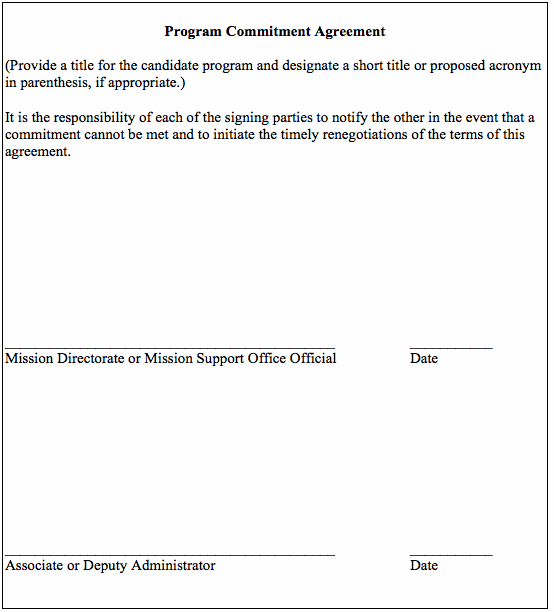Appendix D. Program Commitment Agreement Template
D.1 PCA Title Page

Figure D-1 Program Commitment Agreement Title Page
D.2 PCA Template
PROGRAM COMMITMENT AGREEMENT
(PROGRAM TITLE)
1.0 PROGRAM OBJECTIVES
Identify the broad program objectives. Describe the program's relationship to Mission Directorate or Mission Support Office requirements. Convey the public good of the program to the taxpayer, stated in a way that can be understood by the average citizen.
2.0 PROGRAM OVERVIEW
Describe the strategy to achieve the above-mentioned objectives. Relationships with external organizations, other agencies, or international partners should be addressed if achievement of the program objectives is dependent on their performance. Identify the associated projects governed by the program.
3.0 PROGRAM AUTHORITY
Describe the NASA organizational structure for managing the program and projects from the Mission Directorate or Mission Support Office to the NASA Centers, other internal organizations, and project managers. Include lines of authority and reporting, organizational responsibilities, the Governing Body (e.g., OMC) for the oversight of the program and its projects, and the approving official for new projects.
4.0 TECHNICAL PERFORMANCE COMMITMENT
Summarize the performance metrics with goal and minimum thresholds needed to achieve the program objectives. If the objectives include a technical performance target (goal) in addition to a threshold requirement, the commitment could be stated as a range.
5.0 SCHEDULE COMMITMENT
Identify the following key target milestones for each project in the program, such as:
1. Start of Formulation.
2. Target date or timeframe for the NAR.
3. Start of Implementation.
4. End of Implementation.
5. Other milestones or time periods, as appropriate for the specific program.
6.0 COST COMMITMENT
Provide the maximum estimated cost for the program. This will incorporate programmatic constraints and can be demonstrated by including a table of all projects in Formulation and Implementation for the current year and nine-year horizon. (The actual cost plan is developed during the annual PPBE process.) The cost commitment includes all full-cost data necessary to perform the program, including, but not limited to, standard project activities, facilities costs, deployment, sustaining operations maintenance, data analysis, and decommissioning. For more information on full cost and practices, see Volume 7 of the NASA Financial Management Requirements.
7.0 ACQUISITION STRATEGY
Provide a brief statement of the proposed acquisition strategy for major program elements.
8.0 HIGH-RISK AREAS
Identify the areas of highest risk for the program (covering safety, technical, institutional, cost, or schedule issues) in which failure may result in changes to the program baseline cost, schedule, or technical performance requirements. This section should identify, where possible, the specific risk drivers, such as high-risk technologies upon which the program is dependent.
9.0 INTERNAL AGREEMENTS
If the program is dependent on other NASA activities outside the Mission Directorate or Mission Support Office's control to meet program objectives, identify the required support and list any formal agreements required.
10.0 EXTERNAL AGREEMENTS
Explain the involvement of external organizations, other agencies, or international support necessary to meet the program objectives. Include a brief overview of the program relationships with such external organizations. Include an identification of the commitments being made by the external organizations, other agencies, or international partners and a listing of the specific agreements to be concluded. Any unique considerations affecting implementation of required NASA policies and processes necessitated by the external involvement should be clearly identified.
11.0 INDEPENDENT ASSESSMENTS
Specify the type of independent assessments that will be performed during the program life cycle.
12.0 OUTCOMES
Identify the discrete set of expected deliverables (outcomes) that flow from the Agency goals and objectives as defined in the Agency Strategic Plan.
13.0 WAIVERS
Identify waivers that will be sought for the program. Provide rationale consistent with program characteristics such as scope, complexity, visibility, cost, safety, and acceptable risk.
14.0 PCA ACTIVITIES LOG
Provide and maintain a log of all PCA activities, including revisions that reflect all deviations to the original PCA. This log includes the information shown in Figure D-2 and may be supplemented with an attached addendum for each change, describing the change. The PCA should be updated to add approved projects or whenever substantial change makes it necessary.
| | | | Cancellation | Mission Directorate or Mission Support Office Official | Associate or Deputy Administrator |
| Date | Event | Change | Addendum | Review Req'd | Signature | Signature |
| dd/mm/yy | Revalidation | None | N/A | No | | |
| dd/mm/yy | Revalidation | None | N/A | No | | |
| dd/mm/yy | Approval of new project |
Addition of Project N | Ref. #1 | No | | |
Figure D-2 Sample Program Commitment Agreement Activities Log
DISTRIBUTION:
NODIS
This Document is Obsolete and Is No Longer Used.
Check the NODIS Library to access the current version:
http://nodis3.gsfc.nasa.gov
![[NASA Logo]](../Images/nasaball.gif)
